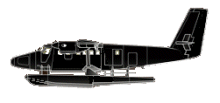
ASN Wikibase Occurrence # 321048
| Date: | Thursday 22 September 2011 |
| Time: | 13:18 |
| Type: |  de Havilland Canada DHC-6 Twin Otter 300 |
| Owner/operator: | Arctic Sunwest Charters |
| Registration: | C-GARW |
| MSN: | 367 |
| Year of manufacture: | 1973 |
| Total airframe hrs: | 33355 hours |
| Engine model: | Pratt & Whitney Canada PT6A-27 |
| Fatalities: | Fatalities: 2 / Occupants: 9 |
| Aircraft damage: | Substantial, repaired |
| Category: | Accident |
| Location: | Yellowknife, NT -
 Canada Canada
|
| Phase: | Approach |
| Nature: | Passenger - Non-Scheduled/charter/Air Taxi |
| Departure airport: | Thor Lake, NT |
| Yellowknife Waterdrome, NT | |
| Investigating agency: | TSB |
| Confidence Rating: |
A de Havilland Canada DHC-6 Twin Otter 300 float plane sustained substantial damage when it crashed in a street next to Yellowknife Waterdrome, NT, Canada. Both pilots were killed and five of the seven passengers were injured.
The airplane had departed from Thor Lake, NT at 12:48 on a flight to the Yellowknife Waterdome. The first officer (FO) was acting as the pilot flying (PF) in the right seat, and the captain was the pilot not flying (PNF) in the left seat. The crew obtained weather information from the Yellowknife Airport automatic terminal information service (ATIS) and briefed their planned approach to the waterdrome. When joining a left base for landing, C-GARW was advised by the Yellowknife Airport control tower, located about 6 nautical miles (11 km) west of the waterdrome, that the winds at the airport were variable from the southwest at 10 knots, gusting to 30 knots.
Due to the 2 to 3-foot waves (rollers) on the lake, the crew planned their approach so as to land close to the shore and to avoid entering the passage between the shore and Jolliffe Island. The captain also advised that the airspeed should be kept above 80 knots indicated airspeed (KIAS), which is 10 KIAS above the normal approach speed of 70 KIAS, for the full-flap (37.5°) approach and landing. During the approach, the captain cautioned the FO twice about the airspeed getting too low. The aircraft touched down in the intended landing area and bounced, then contacted the water a second time with the right float first. The float dug in, and the aircraft yawed to the right, turning towards the shore. The stall warning sounded for about 0.3 seconds.
Without declaring that he was taking control, the captain placed his right hand on the power lever over the FO's left hand and initiated full power for a go-around. C-GARW lifted off in a nose-high, right-wing-low attitude, in a right turn that continued at a low altitude over the shore and toward the buildings in Old Town, Yellowknife. At this time, the captain called for the flaps to be raised to 20°, to which the FO responded. However, the flaps were not moved before impact. The right wing contacted power lines, causing the aircraft to rotate to a nose-down attitude. The bottom of the floats then contacted the side of a 3-storey office building. C-GARW dropped to the ground on its nose section, then cart-wheeled to its left into an adjacent parking lot. The stall warning intermittently activated throughout the go-around until just prior to impact.
The total elapsed time from the initiation of the go-around to the command that flaps be set to 20° was about 4 seconds, and, from that command to the final impact, about 6 seconds. The maximum altitude gained was approximately 50 feet above ground.
Numerous witnesses to the accident were on scene immediately to assist in evacuating the passengers. There was no fire, although a considerable amount of fuel was spilled.
FINDINGS AS TO CAUSES AND CONTRIBUTING FACTORS
1. Airspeed fluctuations at touchdown, coupled with gusty wind conditions, caused a bounced landing.
2. Improper go-around techniques during the recovery from the bounced landing resulted in a loss of control.
3. It is possible that confused crew coordination during the attempted go-around contributed to the loss of control.
Accident investigation:
 |
|
Sources:
CADORS #2011C3593
Yellowknife plane crash kills 2 people (CBC, 22-9-2011)
Location
Images:

photo (c) cambridgebayweather; Cambridge Bay Airport, NU (YCB/CYCB); 08 May 2008; (CC:by-sa)
Revision history:
| Date/time | Contributor | Updates |
|---|
The Aviation Safety Network is an exclusive service provided by:


 ©2024 Flight Safety Foundation
©2024 Flight Safety Foundation